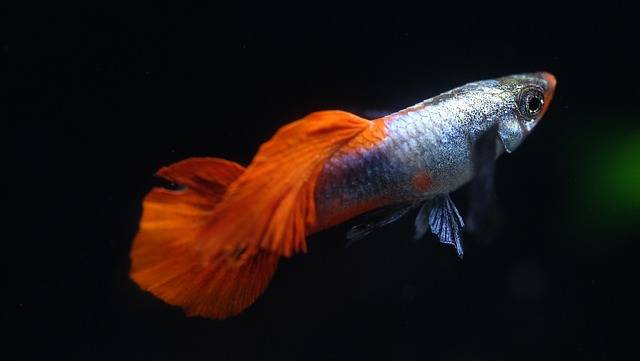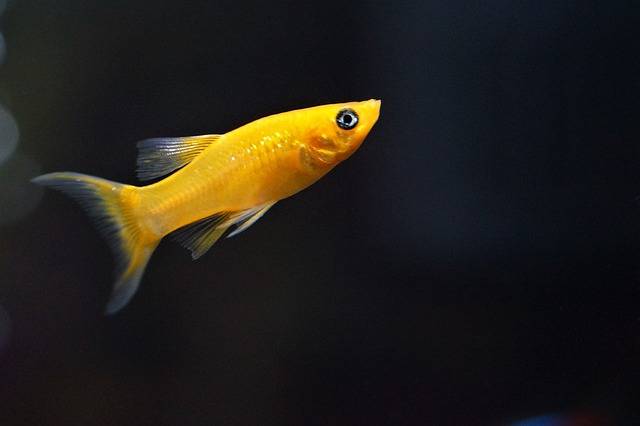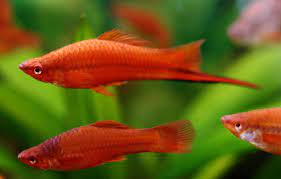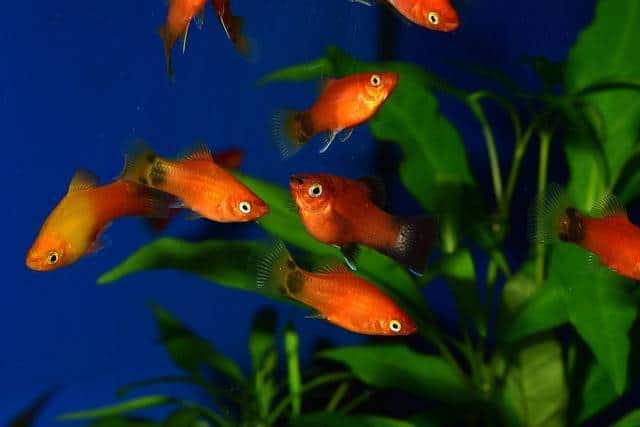Table of Contents
Introduction to Livebearers
Livebearers are a group of freshwater fish that are popular among aquarium hobbyists. They are known for their ease of breeding and their ability to produce live young, rather than laying eggs. In this article, we’ll take a look at the 5 best livebearers for a breeding tank and what makes them ideal for the hobby.
What are Livebearers?
Livebearers are a group of freshwater fish that include species such as guppies, mollies, platies, and swordtails. These species are characterized by their ability to produce live young, rather than laying eggs. This makes them ideal for hobbyists who are looking to breed fish in their aquariums.
Why are Livebearers Ideal for a Breeding Tank?
There are several reasons why livebearers are ideal for a breeding tank. Firstly, they are relatively easy to care for and maintain, making them suitable for hobbyists of all levels. Secondly, they are known for their ability to breed easily and produce large numbers of young, making them an excellent choice for those who are looking to breed fish in their aquarium. Finally, livebearers come in a range of sizes, colors, and temperaments, making them ideal for hobbyists who want to create a diverse and interesting breeding tank.
The Top 5 Livebearers Fish of all time
Guppies (Poecilia reticulata)

Guppies are one of the most popular species of livebearers and are known for their vibrant coloration and energetic personalities. They are easy to care for and make a great addition to any breeding tank.
Breeding Requirements:
To breed guppies, you’ll need a breeding tank with a minimum of 10 gallons of water, a pH of 7.0 to 7.5, and a water hardness of 10 to 20 dH. The water temperature should be between 72 to 82°F. Guppies also prefer a well-planted tank with plenty of hiding places for the females.
Water Parameters:
Guppies are adaptable fish that can tolerate a wide range of water parameters. They prefer a neutral pH of 7.0 to 7.5, a water hardness of 10 to 20 dH, and a water temperature of 72 to 82°F.
Male to Female Ratio:
The ideal male to female ratio for guppies is 1:2 to 1:3, with a higher number of females in the tank to reduce aggression towards them.
Appearance:
Guppies are vibrant fish that come in a variety of colors, including red, orange, yellow, green, and blue. They have a distinctive, triangular-shaped tail and can grow up to 2 inches in length.
Care:
Guppies are easy to care for and are a great choice for beginner aquarists. They are hardy fish that can tolerate a wide range of water conditions, but do require a well-maintained tank and a varied diet of high-quality dry food, live or frozen food, and occasional plant matter.
Compatibility:
Guppies are peaceful fish that get along well with other livebearers and peaceful community fish. They can be kept in a breeding tank with other species of livebearers as long as their water parameters and needs are similar.
Overall, guppies are a fun and vibrant species of livebearer that are easy to care for and great for a breeding tank. They are sure to bring color and energy to any community aquarium.
Mollies (Poecilia sphenops)

Mollies are another popular species of livebearer that are known for their vibrant coloration and hardy nature. They are easy to care for and make a great addition to any breeding tank.
Breeding Requirements:
To breed mollies, you’ll need a breeding tank with a minimum of 20 gallons of water, a pH of 7.5 to 8.5, and a water hardness of 10 to 30 dH. The water temperature should be between 72 to 82°F. Mollies also prefer a well-planted tank with plenty of hiding places for the females.
Water Parameters:
Mollies are adaptable fish that can tolerate a wide range of water parameters. They prefer a slightly alkaline pH of 7.5 to 8.5, a water hardness of 10 to 30 dH, and a water temperature of 72 to 82°F.
Male to Female Ratio:
The ideal male to female ratio for mollies is 1:2 to 1:3, with a higher number of females in the tank to reduce aggression towards them.
Appearance:
Mollies are vibrant fish that come in a variety of colors, including black, silver, gold, and green. They have a distinctive, round-shaped tail and can grow up to 4 inches in length.
Care:
Mollies are easy to care for and are a great choice for beginner aquarists
Swordtails (Xiphophorus helleri)

Swordtails are another popular choice among aquarium hobbyists who are interested in breeding livebearers. They are often referred to as “green swords” due to the distinctive green stripe running down the length of their tails. Swordtails are hardy and adaptable, making them a great choice for beginner hobbyists.
Breeding Requirements: Swordtails are relatively easy to breed and can be kept in a community tank with other peaceful fish species. It is recommended to keep a breeding pair in a breeding tank that is at least 10 gallons in size, with plenty of hiding spots and vegetation. The water temperature should be kept between 72-82°F, with a pH of 7.0-7.5.
Water Parameters: Swordtails are tolerant of a wide range of water conditions and do well in water that is slightly alkaline. They prefer water that is clean and well-filtered, with a moderate flow rate. It is recommended to change 25% of the water every week to keep the water quality high.
Male to Female Ratio: It is recommended to keep a ratio of one male to two females in a breeding tank. This will reduce the risk of the male harassing the females and will also increase the chances of successful breeding.
Endler’s Livebearers (Poecilia wingei)

Endler’s Livebearers are a small, brightly colored livebearer species that are native to the freshwater rivers of Venezuela. They are a peaceful species that are well suited for a community tank and are easy to breed, making them a great choice for beginner hobbyists.
Breeding Requirements: Endler’s Livebearers are easy to breed and do well in a breeding tank that is at least 10 gallons in size. The water temperature should be kept between 72-82°F, with a pH of 7.0-7.5. It is important to provide plenty of hiding spots and vegetation for the female to lay her eggs in.
Water Parameters: Endler’s Livebearers are adaptable to a wide range of water conditions and do well in water that is slightly alkaline. They prefer water that is clean and well-filtered, with a moderate flow rate. It is recommended to change 25% of the water every week to keep the water quality high.
Platies

Platies are another popular livebearer species and are known for their vibrant colors and energetic behavior. They are a small fish, typically growing to about 2-3 inches long, and are native to Central America. Platies are easy to care for, making them a great choice for beginner aquarists.
Breeding Requirements:
Platies are easy to breed and will readily do so in an aquarium. To encourage breeding, you should provide plenty of hiding places, such as caves or dense vegetation, for the female to retreat to after giving birth. Platies will also breed more readily if the water temperature is kept between 72-82°F and the pH level is between 7.0-8.0.
Water Parameters:
Platies prefer a neutral pH between 7.0 and 8.0, with a water hardness between 5-15 dH. They are adaptable to a wide range of water temperatures, but prefer a temperature range between 72-82°F.
Male to Female Ratio:
For a healthy and stable platy population, it’s recommended to have 2-3 females for every male. This will help prevent aggression from the male and ensure that the females have time to recover between breeding cycles.
How to Create the Optimal Environment for Your Livebearing Fish
To ensure that your livebearer fish thrive and breed successfully, it’s important to create an optimal environment for them. This includes providing a suitable tank size, maintaining the right water temperature, and ensuring that the pH balance levels are within the appropriate range.
Tank Size:
The size of the tank is important when it comes to keeping livebearer fish. As a general rule, you should have at least 10 gallons of water for every three fish. This will provide enough space for the fish to swim and reduce the risk of aggression between the fish. Larger tanks will also provide a more stable environment, as changes in water chemistry and temperature are less noticeable in larger volumes of water.
Water Temperature:
The water temperature is an important factor in keeping livebearers healthy and breeding successfully. Most species prefer a temperature range between 72-82°F. It’s important to maintain a stable temperature, as sudden changes in temperature can stress the fish and lead to disease. You can use a thermometer to monitor the water temperature, and you can use a heater to maintain a consistent temperature.
pH Balance Levels:
pH balance refers to the acidity or alkalinity of the water. Livebearer fish prefer a neutral pH between 7.0 and 8.0. Maintaining the pH balance is important for the health of the fish, as sudden changes can cause stress and lead to disease. You can use a pH test kit to monitor the pH levels, and you can use a pH adjuster to raise or lower the pH as needed.
The Best Foods for Your Live Bearing Fish and How to Feed Them Properly
Livebearer fish, such as guppies, mollies, and platies, are omnivores, meaning that they eat both plant and animal matter. To ensure that your fish remain healthy and grow to their full potential, it’s important to feed them a well-balanced diet.
Live Foods vs. Frozen Foods:
Livebearer fish can be fed both live and frozen foods. Live foods, such as brine shrimp, daphnia, and bloodworms, are highly nutritious and provide a source of protein that is essential for growth and reproduction. Frozen foods, such as krill, mysis shrimp, and algae, are also an excellent option for livebearer fish, as they are convenient and easy to store.
How Often Should You Feed Them:
Livebearer fish should be fed two to three times a day, providing them with just enough food to eat in two minutes. Overfeeding can lead to excess waste, which can pollute the water and create a harmful environment for the fish. It’s also important to vary the diet to ensure that the fish receive a well-balanced meal, including both plant and animal matter.
Feeding Techniques:
To feed your livebearer fish, simply drop the food into the water, and let the fish come to it. If you have a lot of plants in the aquarium, you may need to feed the fish in a different location, such as in a separate feeding area, to ensure that all the fish get a chance to eat. You can also use a feeding ring, which is a floating device that holds the food, allowing the fish to feed more easily.
Common Health Issues in Live Bearers and How to Treat Them
Keeping livebearer fish in your aquarium can be a rewarding and enjoyable experience, but it’s important to be aware of common health issues that can arise. By being proactive and taking the necessary steps to prevent illness, you can help ensure that your fish remain healthy and thrive.
Parasites:
One of the most common health issues in livebearer fish is parasite infestations. Parasites, such as Ich, can cause symptoms such as white spots on the skin, loss of appetite, and lethargy. To treat parasites, it’s important to remove the infected fish from the main tank and treat them in a separate quarantine tank. You can use an aquarium-safe parasite treatment, such as copper or malachite green, to kill the parasites.
Bacterial Infections:
Bacterial infections can also occur in livebearer fish and can cause symptoms such as cloudy eyes, red streaks, or open sores. To treat bacterial infections, you can use an aquarium-safe antibacterial treatment, such as kanamycin or nitrofuranace. It’s also important to keep the aquarium clean and maintain good water quality, as poor water conditions can lead to the development of bacterial infections.
Prevention:
The best way to prevent health issues in livebearer fish is to maintain a clean and healthy environment. This includes keeping the water temperature and pH levels within the recommended range, performing regular water changes, and ensuring that the fish have plenty of hiding places and hiding spaces. You should also be mindful of the signs of illness and seek veterinary help if necessary.
Tips on Breeding Your Own Group of Live Bearing Fish at Home
Breeding your own group of livebearing fish at home can be a rewarding and educational experience. Not only do you get to watch the fish grow and develop, but you also get to enjoy the excitement of adding new fish to your aquarium. Here are some tips to help you get started:
Choose the Right Species:
Choose a species of livebearing fish that is suitable for breeding in your home aquarium. Some popular species for breeding include guppies, mollies, platies, and swordtails. Consider the size of your tank, water parameters, and your own experience level when choosing a species.
Establish a Breeding Tank:
Set up a separate breeding tank for your livebearing fish. This will give the fish plenty of space to breed and will also help prevent any aggressive behavior that may occur between the male and female fish.
Maintain Proper Water Conditions:
Maintain the proper water temperature and pH levels in the breeding tank. Livebearing fish prefer a temperature of around 78°F and a pH of 7.0-8.0. Regular water changes and a good filtration system will help maintain a healthy environment for the fish.
Male to Female Ratio:
Maintain a healthy male to female ratio in the breeding tank. A ratio of 1 male to 2-3 females is recommended, as this will help prevent aggressive behavior and will also increase the chances of successful breeding.
Provide Hiding Places:
Provide plenty of hiding places for the fish in the breeding tank. This will help reduce stress and will also give the female fish a place to retreat to if she is being pursued too aggressively by the male fish.
Feed Them Properly:
Feed the livebearing fish a balanced and varied diet. Offer them a variety of live, frozen, and dry foods, and make sure that they are eating enough food to maintain their health and vitality.
Observe the Fish:
Observe the fish regularly to monitor their behavior and to look for any signs of stress or illness. If you notice any changes in behavior, it may be a sign that the fish are not comfortable in their environment, and you may need to make adjustments.
Separate Fry:
When the fry are born, separate them from the adult fish and place them in a separate tank. This will help prevent the adults from eating the fry and will also give the fry a safe environment to grow and develop in.
Conclusion
Live bearing fish are a great addition to any aquarium due to their bright colors, active personalities, and ease of breeding. With proper care and attention, live bearers can thrive in your aquarium and provide a fascinating and interactive hobby for years to come. By understanding their specific needs such as appropriate tank size, water temperature, pH levels, and proper feeding techniques, you can create an optimal environment for your fish to flourish. Additionally, by being aware of common health issues and knowing how to treat them, you can ensure that your live bearers remain happy and healthy. Whether you’re a seasoned aquarist or just starting out, live bearing fish are a wonderful species to have and to breed. So why not start your own group of live bearers today and unlock the secrets of this fascinating and rewarding hobby.
FAQs
What are livebearers in the aquarium hobby?
Livebearers are fish species that give birth to live young rather than laying eggs.
What are the best livebearers for a breeding tank?
The best livebearers for a breeding tank include Guppies, Mollies, Platies, Swordtails, Endler’s Livebearers and more.
What are the breeding requirements for livebearers?
Breeding requirements for livebearers include a suitable breeding tank, water parameters within their preferred range, a male to female ratio of 1:2 to 1:3, and adequate hiding places for the females.
What water parameters should I maintain for livebearers?
The ideal water parameters for livebearers vary by species but typically include a pH of 7.0 to 7.5, a water hardness of 15 to 25 dH, and a water temperature of 72 to 80°F.
What is the male to female ratio for livebearers?
The ideal male to female ratio for livebearers is 1:2 to 1:3, with a higher number of females in the tank to reduce aggression towards them.
Can I keep different species of livebearers in the same tank?
Yes, different species of livebearers can be kept together in the same tank as long as their water parameters and needs are similar.
How do I care for livebearer fry?
Livebearer fry can be cared for by providing them with a separate fry tank, keeping the water parameters within their preferred range, feeding them small amounts of suitable food several times a day, and avoiding overcrowding.
How often do livebearers give birth?
Livebearers give birth on average every 4 to 6 weeks, but this varies by species and the conditions in the tank.
What should I feed livebearers?
Livebearers should be fed a varied diet of high-quality dry food, live or frozen food, and occasional plant matter.
What is the average lifespan of livebearers?
The average lifespan of livebearers varies by species, but ranges from 2 to 5 years with proper care and conditions.
References for Livebearers
- Livebearers Unlimited: https://www.livebearers.org/
- The Livebearer Society: http://www.livebearersociety.com/
- American Livebearer Association: http://www.americanlivebearer.org/
- Livebearer Resource: http://livebearer.com/
- Livebearers.com: http://livebearers.com/
These resources provide extensive information on livebearers, including their care, breeding, history, and much more. Whether you’re a beginner or an experienced aquarist, these resources can be a valuable source of information and support.
You may also be interested in other articles please check out The Ultimate Guide to 10 Best Low-Maintenance Fish for a Beginner Aquarium in 2023 and The Ultimate Guide to Setting Up a Saltwater Aquarium
I am a passionate aquarist with over 30 years of hands-on experience in fishkeeping. My journey began at a young age, collecting fish from the wild and learning through experimentation. Specializing in tropical fish, I bring a deep understanding of the hobby to FishKeepingMadeSimple. The site provides honest, detailed reviews of essential products and accessories to help fellow enthusiasts create the best environments for their fish.










[…] to fostering their health and natural behaviors. Whether you’re a seasoned aquarist or new to fishkeeping, join us on a journey to discover the beauty and tranquility these mesmerizing fish bring to the […]
[…] maintaining health and promoting growth, making them a beloved ornamental Arowana species in the aquarium […]
[…] home to help them feel comfortable. With good care, your shrimp family will thrive and make your aquarium […]
[…] blue rams, look for peaceful fish. These cichlids get along well with many other species in a community aquarium. Here are some good choices for […]
[…] Plants can help to absorb excess nutrients and provide oxygen, which helps to maintain a healthy aquarium environment for your […]
[…] Bacterial infections are a big threat to shrimp colonies. They can spread fast and kill many shrimp in just weeks. Shrimp diseases, especially those from Vibrio spp., are major killers. These germs harm shrimp when their defenses are down due to bad water, poor food, pollutants, and stress. […]
[…] feeding and adjust as needed. Include high-quality fish food, sinking shrimp pellets, and small frozen foods. Vegetables like spinach or kale are also good. Protein-rich foods, like Pure Nordic Aminostix, […]